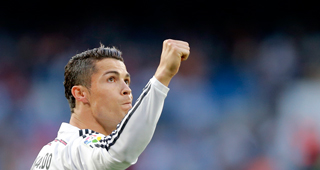Worldwide viewership of El Clasico beats the Super Bowl and by the very nature of the assemblage of Barcelona and Real Madrid, it always promises to feature more than a dozen players with enough quality to build an entire Champions League team around. This is the ultimate theater of what sports can be with its combination of athletic aesthetics, severe rivalry and nearly a century of proxy politics. It is always much more than a soccer match, but this first one of the 15-16 season follows a harrowing international break.
The sobriety of the moment is somehow strangely appropriate since the Barcelona-Real Madrid rivalry feels like it’s in a state similar to the late 1980s USA/USSR period of cooling down.
Removing the human flamethrower that was Jose Mourinho and his demonstrative sideline antics and diatribe press conferences of paranoid narcissism from the equation in 2013 helped usher in some semblance of respect and decency of a rivalry that was for a time ruled by eye pokes and the expected cynical run of yellow cards.
The first part of this season has determined Real Madrid isn’t quite big enough for both Cristiano Ronaldo and Gareth Bale, while Lionel Messi’s extended injury absence has proven Neymar is capable of being even bigger and better than we thought. For as much powerful infrastructure and talent that exists at Barcelona, the deep, unspoken fearful question for them is how much propping up has Messi being doing all these years? Certainly a lot, but the blueprint for a life for Barcelona with Messi a step slower or even gone altogether is a good one nevertheless. Barcelona has gone from one point down to three points up with Neymar playing so well during Messi's absence and 20 of their 23 goals have been scored by Neymar or Suarez.
Xavi and Iker Casillas exited last season and there is also a very real possibility Ronaldo will be playing in his final Bernabeu Clasico. It’s getting closer, the end of this Clasico era defined by the dominance of Barcelona, mighty Real Madrid as the underdog upstarts, and the unavoidable and unceasing Ronaldo versus Messi debate.
There is an anticipatory nostalgia going into this match that the insularity of this rivalry has already reached its climax.
As this era winds down, it will be interesting how both club’s relentless use of counterforce against the other on the transfer market will evolve and very possibly change. Those Premier League television rights dollars, the economic rise of Paris Saint-Germain, and Bayern Munich going global have made Real Madrid and Barcelona no longer automatically capable of always being entangled side-by-side as the first in line for the choicest cuts of superstars.
For example, Ronaldo doesn’t necessarily go from Manchester United to Real Madrid as easily in the TV boom era of 2015 as he did during the worldwide recession of 2009.
The signing of Ronaldo in the first place for a world record £80 million was needed by Real Madrid to offset the homegrown rise of Messi and Barcelona’s sextuple in 08-09. Ronaldo wanted Real Madrid, Real Madrid wanted Ronaldo and the return of Florentino Perez that year made it a reality as he was promising Galacticos, Version 2.0 to again compete against Barcelona.
The Ronaldo signing was made in tandem the same week with Kaka coming to Madrid from AC Milan for £56 million, then came Karim Benzema for £35 million from Lyon, and the summer was wrapped up in August with Xabi Alonso for £30 million from Liverpool. While Kaka was nowhere close to the Ballon d’Or player of his early career, Ronaldo, Benzema and Alonso became the core of the Real Madrid team that closed the gap against Barcelona during the next few seasons, culminating in winning La Liga in 2012 and the Champions League in 2014.
Despite Barcelona’s position of dominance, they responded to Real Madrid’s impressive reinforcement call by signing Zlatan Ibrahimovic for £57 million from Inter Milan, using Samuel Eto’o as a makeweight. The outsized personality of Zlatan plays so well for some clubs, but he was anathema to both Pep Guardiola and even Messi. Barcelona attempted to atone for the move immediately by sending him to Milan on loan that became permanent at a 65 percent discount of what they paid.
Because Barcelona had successfully built so much of their team with La Masia players like Xavi, Andres Iniesta and Sergio Busquets entering their prime, there was little room for many significant signings in the next few years, while it was more about adding finishing pieces than breaking transfer records for Real Madrid.
David Villa had been a target of Real Madrid in 2009, but he came to Barcelona in 2010 for €40 million to help fix the Zlatan mistake. Yaya Toure was sent out to Manchester City with Busquets emerging.
Mourinho was hired by Real Madrid in 2010, which in itself was a move of desperation as he’s nothing if not a results-obsessed pragmatist.
Without La Masia to supply Real Madrid of young talent, Perez bought Angel di Maria, Mesut Ozil and Sami Khedria for €33 million, €18 million and €14 million respectively in 2010 to give Mourinho young, moldable players.
Real Madrid had finished nine points behind Barcelona during that 08-09 La Liga season and closed it to three in 09-10 and four in 10-11 while also playing them competitively in the Champions League semifinals and winning Copa del Rey. But it was still Barcelona winning La Liga and the Champions League.
Cesc Fabregas came home from Arsenal in 2011 despite nearly joining Real Madrid, and Alexis Sanchez was bought from Udinese, but Real Madrid essentially counted on the core of that 10-11 squad coalescing in Year 2 under Mourinho and it worked by winning La Liga in 11-12.
Barcelona lost to Chelsea 3-2 on aggregate with a stoppage time goal by Fernando Torres in the semifinals of the Champions League, while Real Madrid lost to Bayern on penalties the next day. The Clasico final in Munich at the apex of this rivalry had eluded us.
Barcelona’s gigantic advantage, real and psychological, over Real Madrid had been erased. Guardiola was exhausted from his four seasons at Barcelona during this highly competitive and stressful period and tapped out to go on his sabbatical before taking a somehow more relaxing assignment in Germany to replace a manager that just won the Champions League in 2013.
Luka Modric became the only meaningful transfer in a tranquil, let’s catch our breath summer of 2012 for what is now a bargain €30 million from Spurs, though fellow Croatian Ivan Rakitic’s €18 million transfer to Barcelona from Sevilla in 2014 was also a shrewd bit of buying.
The 2013 summer renewed the arms race with both clubs attempting to sign Neymar, which has become one of the most controversial transfers in history. The ultimate price for Neymar is in the €86 million range and forced Real Madrid to instead buy Bale from Spurs for €94 million.
Real Madrid won the Copa del Rey and Champions League with Bale playing a critical role, especially ‘that’ match winning goal in the former with Ronaldo in a black hat on the sidelines injured, but his signing has had a domino effect that completely changed the club even beyond the Ronaldo vs. Bale dynamic. The Bale transfer necessitated the sale of Mesut Ozil to Arsenal immediately thereafter, and the Di Maria sale to Manchester United in 2014. Bale also created positional gridlock with Isco and James Rodriguez, who was bought from Monaco for a post-World Cup inflation €80 million after Barcelona was picked by Luis Suarez.
Until Neymar and Suarez were bought, Zlatan was the most expensive purchase in Barcelona history by nearly €30 million and it served as a warning against quick fixes and the possibility of personality clashes when you bring in a mercenary. After an initial period of struggle, the attacking three of Messi, Neymar and Suarez became an all-time great force as they won the treble.
Whether Real Madrid preemptively sells Ronaldo this summer and keeps Bale, or sells Bale and lets Ronaldo age before their eyes moving from the wing to strictly a penalty box player, there is another evolution coming for the club. This not only means bidding against Barcelona, but it also means bidding against supremely rich Chelsea, Manchester United, Manchester City, PSG and Bayern.
The financial prudence of Real Madrid has been revealed in how they handled the David De Gea negotiations, as well as how they’ve again shifted toward younger players like Danilo for €31.5 million, Mateo Kovacic for €29 million, Lucas Silva for €13 million and even 16-year-old Martin Odegaard for €3 million. Keylor Navas, fortunately for Real Madrid, has played brilliantly enough to show just how critical the keeper position is for this version of Real Madrid.
Barcelona seems comfortable poaching Arda Turan from Atletico for €34 million and could follow that up next summer with Koke, or simply bring back Nolito as they did previously with Fabregas.
The next big financial heatcheck, however, will be Paul Pogba since Real Madrid, Barcelona and every other superclub in the world will be vying for him.
There is no untethering Real Madrid and Barcelona, even on the transfer market, but there is now too much galactic traffic to merely remain binaries reactively crossing in the night.



